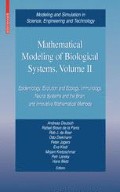Summary
We present a review of the Tangled Nature model. The model is developed to focus on the effect of evolution and multiple interactions on ecological and evolutionary observables. The model is individual based and ecological structures, such as species, are emergent quantities. The dynamics consists of a simplistic mutation-prone multiplication in which the probability of producing an offspring is determined by the occupancy in genotype space. The macroscopic long time dynamics is intermittent and exhibits a slow decrease in the macroscopic extinction rate. Ecological quantities such as the species abundance distribution and the species-area relationship compare qualitatively well with observations, as does the relation between interaction and diversity. The effect of correlations between parents and mutants has been studied, as has the effect of a conserved resource.
Access this chapter
Tax calculation will be finalised at checkout
Purchases are for personal use only
Preview
Unable to display preview. Download preview PDF.
References
Abrams, P.A.: ‘Adaptive dynamics’ vs. ‘adaptive dynamics’. J. Evol. Biol., 18, 1162–1165 (2005).
Drossel, B.: Biological evolution and statistical physics. Adv. in Phys., 50, 209–295 (2001).
Maynard Smith, J.: Evolution and the Theory of Games. Cambridge University Press, Cambridge CB2 2RU (1982).
Drossel, B., Higgs, P.G., McKane, A.J.: The influence of predator-prey population dynamics on the long-term evolution of food web structure. J. Theor. Biol., 208, 91–107 (2001).
Caldarelli, G., Higgs, P.G., McKane, A.J.: Modelling coevolution in multispecies communities. J. Theor. Biol., 193, 345–358 (1998).
Thompson, J.N.: The evolution of species interactions. Science, 284, 2116–2118 (1999).
Hammerstein, P.: Darwinian adaptation, population genetics and the streetcar theory of evolution. J. Math. Biol., 34, 511–532 (1996).
DeAngelis, D.L., Gross, L.J.: Individual-based models and approaches in ecology: populations, communities and ecosystems. Chapman & Hall, New York (1992).
DeAngelis, D.L., Mooij, W.M.: Individual-based modelling of ecological and evolutionary processes. Ann. Rev. of Ecol., Evol., and Sys., 36, 147–168 (2005).
Christensen, K., di Collobiano, S.A., Hall, M., Jensen, H.J.: Tangled nature: A model of evolutionary ecology. J. Theor. Biol., 216, 73–84 (2002).
Anderson, P., Jeldtoft Jensen, H.: Network properties, species abundance and evolution in a model of evolutionary ecology. J. Theor. Biol., 232, 551–558 (2005).
Avogadro di Collobiano, S., Christensen, K., Jensen, H.J.: The tangled nature model as an evolving quasi-species model. J. Phys. A, 36, 883–891 (2003).
Hall, M., Christensen, K., di Collobiano, S.A., Jensen, H.J.: Time-dependent extinction rate and species abundance in a tangled-nature model of biological evolution. Phys. Rev. E, 66, 011904 (2002).
Hubbell, S.: The Unified Neutral Theory of Biodiversity and Biogeography. Princeton University Press, Princeton, NJ 08540 (2001).
Rikvold, P.A., Zia, R.K.P.: Punctuated equilibria and 1/f noise in a biological coevolution model with individual-based dynamics. Phys. Rev. E, 68, 031913 (2003).
Zia, R.K.P., Rikvold, P.A.: Fluctuations and correlations in an individual-based model of evolution. J. Phys. A, 37, 5135–5155 (2004).
Durrett, R., Levin, S.: Spatial models for species-area curves. J. Theor. Biol., 179, 119–127 (1996).
Magurran, A.E., Henderson, P.A.: Explaining the excess of rare species in natural species abundance distributions. Nature, 422, 714–716 (2003).
Lawson, D., Jensen, H.J.: The species-area relationship and evolution. arXiv:q-bio.PE, 0412024 (2005).
Lawson, D., Jensen, H.J., Kaneko, K.: Diversity as a product of interspecial interactions. arXiv:q-bio.PE, 0505019 (2005).
Sevim, V., Rikvold, P.A.: Effects of correlated interactions in a biological coevolution model with individual-based dynamics. arXiv:q-bio.PE, 0507040 (2005).
Laird, S., Jensen, H.J.: The tangled nature model with inheritance and constraint: Evolutionary ecology restricted by a conserved resource. arXiv:q-bio.PE, 0510008 (2005).
Standish, R.K.: Ecolab: where to now? Complexity International, 3, (1996). (See http:// parallel.hpc.unsw.edu.au/rks/docs/newman-model/newman-model.html for a plot of the full lifetime distribution.)
Chowdhury, D., Stauffer, D., Kunwar, A.: Unification of small and large time scales for biological evolution: deviations from power law. Phys. Rev. Lett., 90, 068101 (2003).
Chowdhury, D., Stauffer, D.: Food web based unified model of macro- and microevolution. Phys. Rev. E, 68, 041901 (2003).
Chowdhury, D., Stauffer, D.: Sole-manrubia model of biological evolutions: some new insights. Physica A, 318, 461–468 (2003).
Sole, R.V., Manrubia, S.C.: Extinction and self-organised criticality in a model of large scale evolution. Phys. Rev. E, 54, 42–45 (1996).
Emerson, B.C., Kolm, N.: Species diversity can drive speciation. Nature, 434, 1015–1017 (2005).
May, R.M. (ed): Stability and Complexity in Model Ecosystems in Monographs in Population Biology. Princeton University Press, Princeton, NJ (1974).
McCann, K.S.: The diversity stability debate. Nature, 405, 228–233 (2000).
Haydon, D.T.: Maximally stable model ecosystems can be highly connected. Ecology, 81, 2631–2636 (2000).
Dunne, J.A., Williams, R.J., Martinez, N.D.: Food web structure and network theory: the role of connectance and size. Proc. Natl. Acad. Sci. USA, 99, 12917–12922 (2002).
Metzler, R., Klafter, J.: The random walk’s guide to anomalous diffusion: a fractional dynamics approach. Physics Reports, 339, 1–77 (2000).
Author information
Authors and Affiliations
Editor information
Editors and Affiliations
Rights and permissions
Copyright information
© 2008 Birkhäuser Boston
About this chapter
Cite this chapter
Laird, S., Lawson, D., Jensen, H.J. (2008). The Tangled Nature Model of Evolutionary Ecology: An Overview. In: Deutsch, A., et al. Mathematical Modeling of Biological Systems, Volume II. Modeling and Simulation in Science, Engineering and Technology. Birkhäuser Boston. https://doi.org/10.1007/978-0-8176-4556-4_5
Download citation
DOI: https://doi.org/10.1007/978-0-8176-4556-4_5
Publisher Name: Birkhäuser Boston
Print ISBN: 978-0-8176-4555-7
Online ISBN: 978-0-8176-4556-4
eBook Packages: Mathematics and StatisticsMathematics and Statistics (R0)

